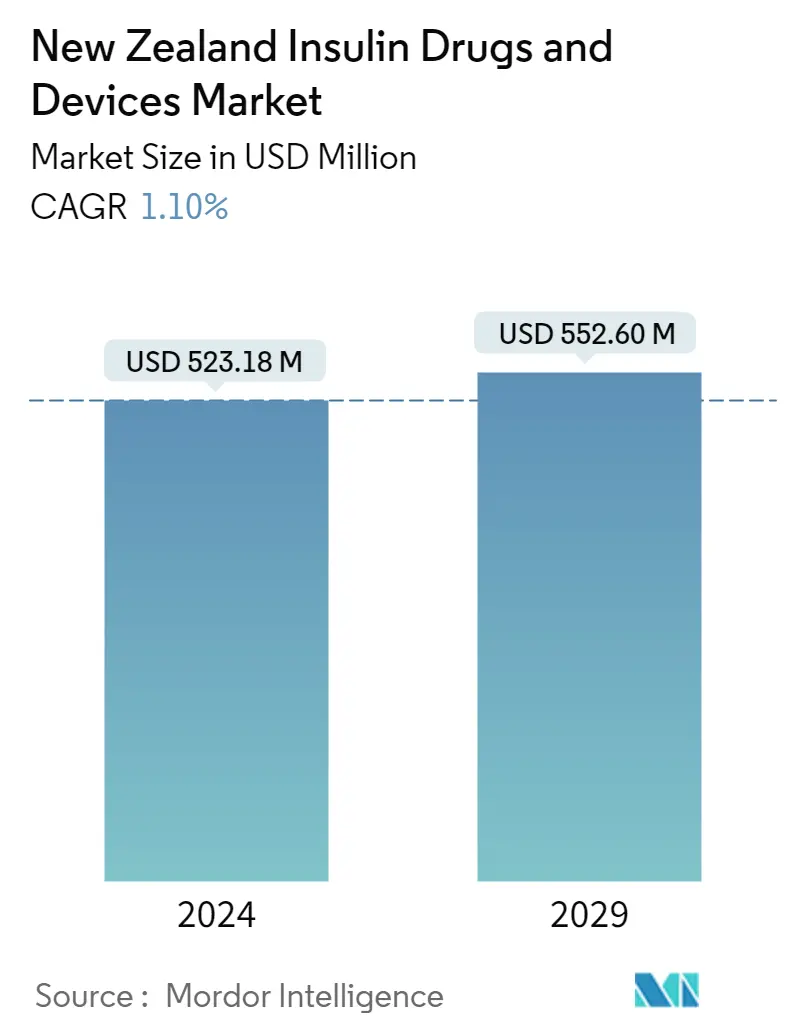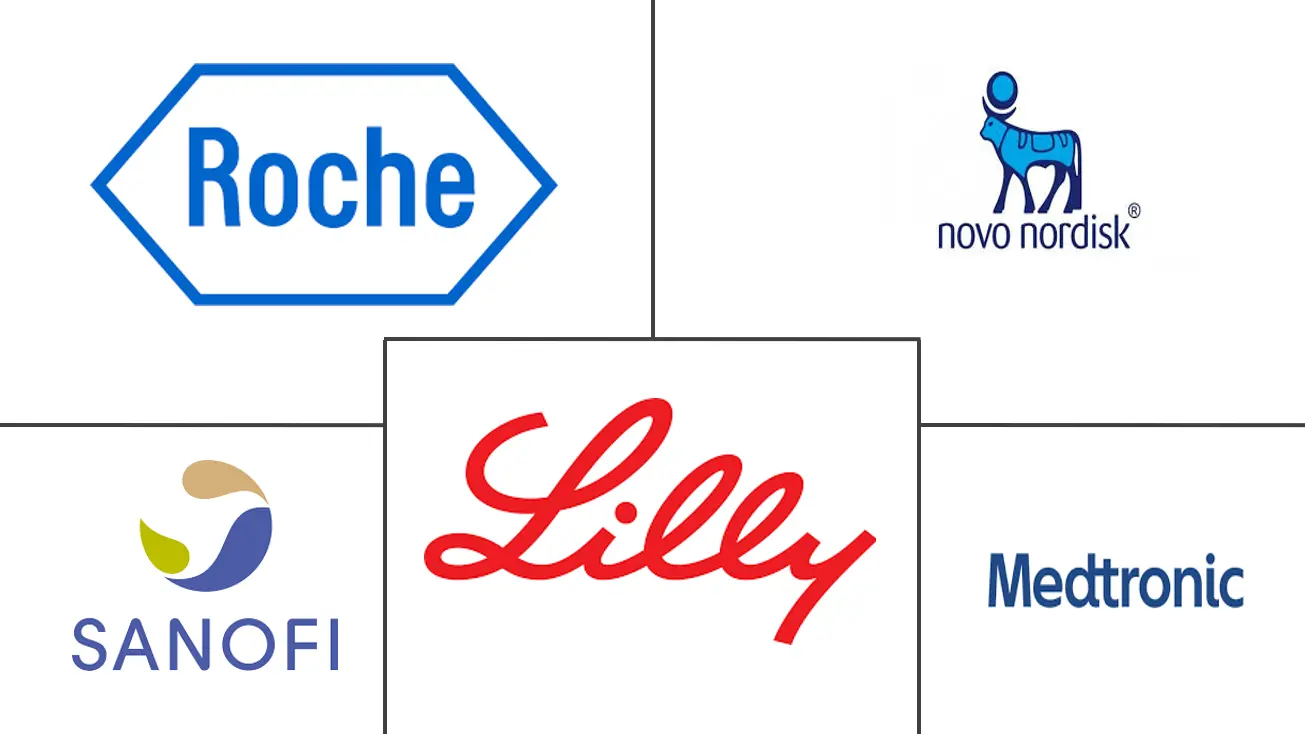Market Size of New Zealand Insulin Drugs and Devices Industry

| Study Period | 2019 - 2029 |
| Base Year For Estimation | 2023 |
| Forecast Data Period | 2024 - 2029 |
| Market Size (2024) | USD 523.18 Million |
| Market Size (2029) | USD 552.60 Million |
| CAGR (2024 - 2029) | 1.10 % |
Major Players
*Disclaimer: Major Players sorted in no particular order |
New Zealand Insulin Drugs & Devices Market Analysis
The New Zealand Insulin Drugs and Devices Market size is estimated at USD 523.18 million in 2024, and is expected to reach USD 552.60 million by 2029, growing at a CAGR of 1.10% during the forecast period (2024-2029).
After COVID-19 was detected, the risk of developing type 1 diabetes increased. The largest risk was in young pediatric and older adult patients with COVID-19. Type 1 diabetic patients were more likely to become infected with the virus and suffer from potentially fatal complications such as diabetic ketoacidosis. It was vital that patients had access to diabetic services and received high-quality clinical treatment, which included diabetes screening, education, and monitoring of complications and control.
To control blood sugar levels, the hormone insulin stimulates the liver, muscle, and fat cells to absorb glucose from the blood. It makes it easier for cells to absorb glucose for cellular energy use. Type 1 diabetes develops when the pancreas cannot produce enough insulin to meet the body's requirements.
Diabetes is typically regarded as a disease connected to lifestyle. The prevalence of the disease has dramatically increased over time due to the rising global population. All those with Type 1 diabetes and between 10% and 25% of those with Type 2 diabetes, totaling around 100 million individuals worldwide, require insulin. More than half of the people in New Zealand who need insulin today still do not have access to it or can afford it, even though insulin has been used to treat diabetes for more than 90 years. Insulin Patients with type-1 diabetes need drugs and delivery systems since their bodies cannot make insulin independently; those with type-2 diabetes also need insulin, especially if they are having trouble controlling their diabetes with oral meds.
New Zealand Insulin Drugs & Devices Industry Segmentation
With the assistance of the Ministry of Health, the NZSSD has established national current, evidence-based recommendations for the management of type 2 diabetes in adults. All health professionals working with persons with type 2 diabetes in New Zealand will find the guidance a clear, practical resource. It will be updated as new research becomes available and clinical practice evolves. The New Zealand Insulin Drugs and Devices Market is set to witness a CAGR of more than 3% during the forecast period. New Zealand Insulin Drugs and Devices Market is segmented into drugs (Basal or Long-acting Insulins, Bolus or Fast-acting Insulins, Traditional Human Insulins, Combination Insulins, Biosimilar Insulins, and Amylin Analogues) and devices (Insulin Pens, Insulin Pumps, Insulin Syringes, and Jet Injectors) and the report offers the value (in USD million) and volume (in million mL) for drugs and volume (in unit million) for devices.
| Insulin Drugs (Value and Volume, 2017 - 2028) | |||||||
| |||||||
| |||||||
| |||||||
|
| Combination drugs (Value and Volume, 2017 - 2028) | |||||
| |||||
|
| Non-Insulin Injectable drugs (Value and Volume, 2017 - 2028) | |||||||
| |||||||
|
| Insulin Device (Value and Volume, 2017 - 2028) | |||||
| |||||
| |||||
| Insulin Syringes | |||||
| Insulin Jet Injectors |
New Zealand Insulin Drugs and Devices Market Size Summary
The New Zealand insulin drugs and devices market is poised for steady growth over the forecast period, driven by the increasing prevalence of diabetes and the critical need for insulin among patients. The market is characterized by a moderate level of consolidation, with key players like Roche, Novo Nordisk, Sanofi, Eli Lilly, and Medtronic leading the charge in innovation and research. Despite the challenges posed by regulatory constraints and the high cost of medications, the availability of insulin and diabetes treatments remains robust, with government agency Pharmac regulating the market to ensure access to essential medications. The healthcare system in New Zealand, divided into primary and secondary care, provides a structured approach to diabetes management, although access to specialized services can vary based on income and need.
The demand for insulin drugs is expected to grow significantly, supported by initiatives such as the New Zealand Society for the Study of Diabetes' guidelines and public health campaigns aimed at increasing awareness and access to diabetes care. The market benefits from the presence of major insulin producers offering a wide range of products, including very short-acting insulin analogs. The ongoing development of new products, coupled with international research collaborations and heightened public awareness, is anticipated to further propel market growth. Despite the challenges of accessing certain pharmaceuticals, New Zealand's healthcare system continues to provide comprehensive support for diabetes management, including free treatment for complications and issues related to the disease.
New Zealand Insulin Drugs and Devices Market Size - Table of Contents
-
1. MARKET DYNAMICS
-
1.1 Market Overview
-
1.2 Market Drivers
-
1.3 Market Restraints
-
1.4 Porter's Five Forces Analysis
-
1.4.1 Bargaining Power of Suppliers
-
1.4.2 Bargaining Power of Consumers
-
1.4.3 Threat of New Entrants
-
1.4.4 Threat of Substitute Products and Services
-
1.4.5 Intensity of Competitive Rivalry
-
-
-
2. MARKET SEGMENTATION
-
2.1 Insulin Drugs (Value and Volume, 2017 - 2028)
-
2.1.1 Basal or Long Acting Insulins
-
2.1.1.1 Lantus (Insulin Glargine)
-
2.1.1.2 Levemir (Insulin Detemir)
-
2.1.1.3 Toujeo (Insulin Glargine)
-
2.1.1.4 Tresiba (Insulin Degludec)
-
2.1.1.5 Basaglar (Insulin Glargine)
-
-
2.1.2 Bolus or Fast Acting Insulins
-
2.1.2.1 NovoRapid/Novolog (Insulin Aspart)
-
2.1.2.2 Humalog (Insulin Lispro)
-
2.1.2.3 Apidra (Insulin Glulisine)
-
-
2.1.3 Traditional Human Insulins
-
2.1.3.1 Novolin/Actrapid/Insulatard
-
2.1.3.2 Humulin
-
2.1.3.3 Insuman
-
-
2.1.4 Biosimilar Insulins
-
2.1.4.1 Insulin Glargine Biosimilars
-
2.1.4.2 Human Insulin Biosimilars
-
-
-
2.2 Combination drugs (Value and Volume, 2017 - 2028)
-
2.2.1 Insulin combinations
-
2.2.1.1 NovoMix (Biphasic Insulin Aspart)
-
2.2.1.2 Ryzodeg (Insulin Degludec and Insulin Aspart)
-
2.2.1.3 Xultophy (Insulin Degludec and Liraglutide)
-
-
2.2.2 Oral Combinations
-
2.2.2.1 Janumet (Sitagliptin and Metformin)
-
-
-
2.3 Non-Insulin Injectable drugs (Value and Volume, 2017 - 2028)
-
2.3.1 GLP-1 receptor agonists
-
2.3.1.1 Victoza (Liraglutide)
-
2.3.1.2 Byetta (Exenatide)
-
2.3.1.3 Bydureon (Exenatide)
-
2.3.1.4 Trulicity (Dulaglutide)
-
2.3.1.5 Lyxumia (Lixisenatide)
-
-
2.3.2 Amylin Analogue
-
2.3.2.1 Symlin (Pramlintide)
-
-
-
2.4 Insulin Device (Value and Volume, 2017 - 2028)
-
2.4.1 Insulin Pumps
-
2.4.1.1 Insulin Pump Devices
-
2.4.1.2 Insulin Pump Reservoirs
-
2.4.1.3 Insulin Infusion sets
-
-
2.4.2 Insulin Pens
-
2.4.2.1 Cartridges in reusable pens
-
2.4.2.2 Disposable insulin pens
-
-
2.4.3 Insulin Syringes
-
2.4.4 Insulin Jet Injectors
-
-
New Zealand Insulin Drugs and Devices Market Size FAQs
How big is the New Zealand Insulin Drugs and Devices Market?
The New Zealand Insulin Drugs and Devices Market size is expected to reach USD 523.18 million in 2024 and grow at a CAGR of 1.10% to reach USD 552.60 million by 2029.
What is the current New Zealand Insulin Drugs and Devices Market size?
In 2024, the New Zealand Insulin Drugs and Devices Market size is expected to reach USD 523.18 million.

